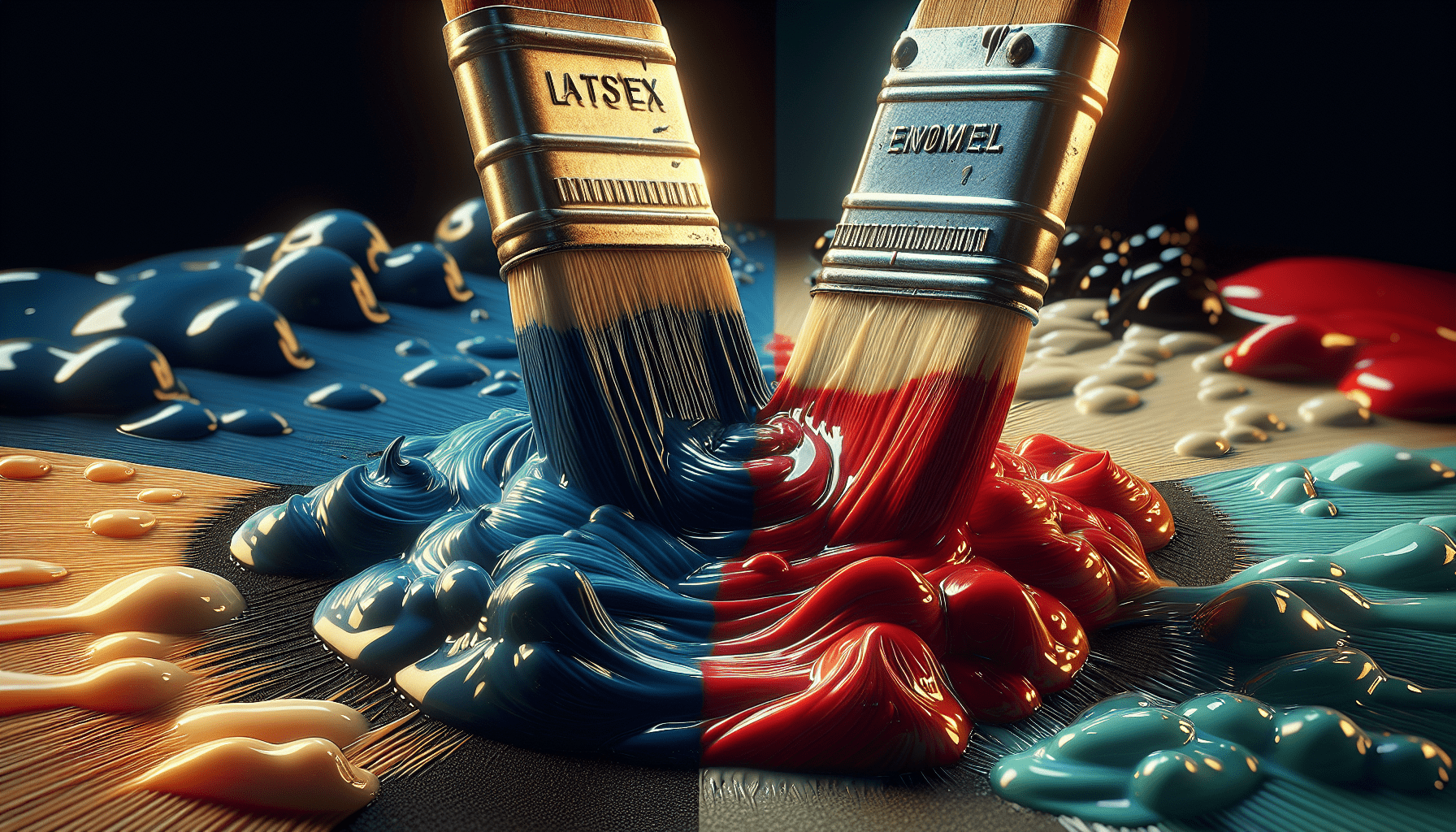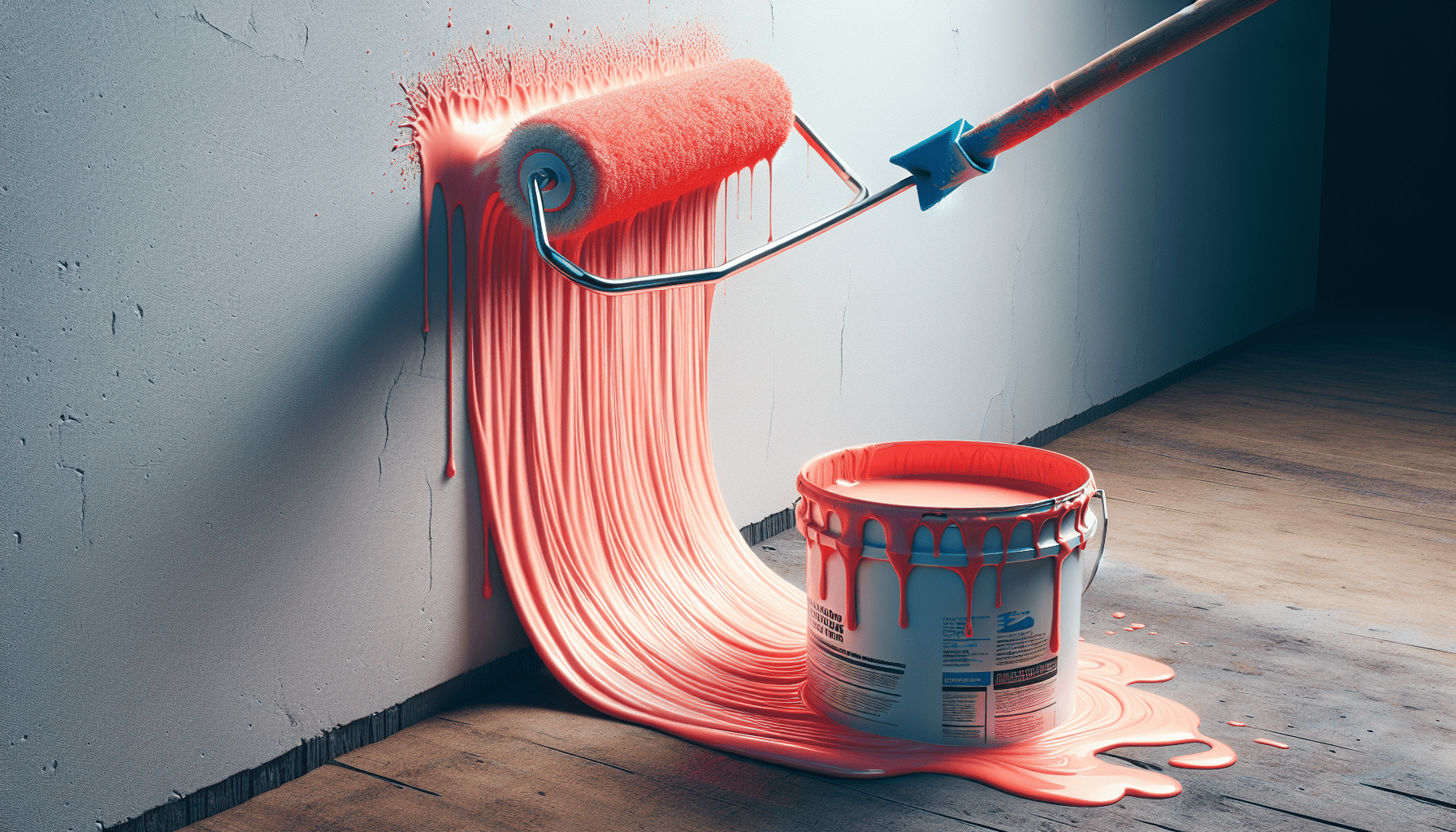In the realm of paint, two commonly used types stand out: latex and enamel. While both serve the purpose of adding color and protection to various surfaces, they possess distinctive characteristics that set them apart. latex paint, for example, is water-based and its formulation includes synthetic resins, which allow for easy cleanup with soap and water. Enamel paint, on the other hand, is typically oil-based and contains solvents that make it more durable and resistant to stains and moisture. Understanding the dissimilarities between these two paints is crucial when embarking on a painting project, as it ensures that the desired outcome is achieved effectively and efficiently.

1. Definition and Composition
Latex Paint
Latex paint, also known as water-based paint, is a type of paint that primarily consists of water and latex resin. It is called latex paint because the resin used in its composition is often made from synthetic rubber latex. The latex resin acts as the binder that holds the pigment particles together, creating a smooth and durable finish. Other additives, such as thickeners, surfactants, and preservatives, may also be added to improve the paint’s performance.
Enamel Paint
Enamel paint, on the other hand, is a type of oil-based paint that is commonly used for its high gloss and durability. Unlike latex paint, enamel paint is made from alkyd resins or oil-based solvents, such as mineral spirits or turpentine. These resins provide a strong and durable film once the paint dries, making enamel paint suitable for high-traffic areas or surfaces that require extra protection. Enamel paint may also contain pigments, additives, and drying agents to enhance its performance and appearance.
2. Drying Time
Latex Paint
One significant advantage of latex paint is its short drying time. Latex paint typically dries within one to two hours. This quick drying time allows for faster completion of painting projects, reducing the waiting time between coats or before using the painted surfaces. Additionally, latex paint releases fewer volatile organic compounds (VOCs) into the air during the drying process, making it a more environmentally friendly option.
Enamel Paint
Enamel paint, being oil-based, has a longer drying time compared to latex paint. The drying time for enamel paint can range from 8 to 24 hours, depending on the environmental conditions and the thickness of the paint layers. The prolonged drying time means that more caution must be exercised during the painting process to avoid smudges or damage to the painted surfaces. Proper ventilation is also crucial due to the higher VOC content of enamel paint.
3. Application
Latex Paint
Latex paint is known for its ease of application. It can be applied to various surfaces, including drywall, wood, plaster, and masonry, using brushes, rollers, or sprayers. The water-based composition of latex paint allows for easy cleanup with just soap and water, reducing the hassle of using solvents for cleaning brushes and equipment. Latex paint also offers good coverage, requiring fewer coats to achieve the desired color and finish.
Enamel Paint
Enamel paint, due to its oil-based nature, requires more meticulous preparation and application. It is commonly used for surfaces such as metal, woodwork, and trim that require a durable and glossy finish. Enamel paint can be applied using brushes, rollers, or spray guns, but it is important to ensure proper ventilation and follow safety precautions due to the higher levels of VOCs. Cleaning the painting tools after using enamel paint involves the use of solvents such as mineral spirits or paint thinner.
4. Durability
Latex Paint
While latex paint provides reasonable durability, it may not be as tough or long-lasting as enamel paint. Latex paint is well-suited for interior walls and surfaces that are not exposed to excessive wear and tear. It is known for its good resistance to cracking, peeling, and fading over time. However, in high-traffic areas or exterior surfaces, latex paint may require more frequent touch-ups or reapplication compared to enamel paint.
Enamel Paint
Enamel paint offers exceptional durability and is often preferred for surfaces that require a strong and long-lasting finish. Its oil-based composition forms a hard and protective coating that withstands abrasion, impact, and moisture more effectively than latex paint. Enamel paint is commonly used on metal surfaces, doors, trims, and furniture where durability is crucial. It provides excellent resistance to chipping, stains, and fading, making it a preferred choice for exterior applications as well.

5. Finish
Latex Paint
Latex paint typically provides a flat, matte, satin, or eggshell finish. These finishes have varying levels of glossiness, with flat being the least glossy and eggshell being slightly more reflective. Latex paint finishes are widely used for interior walls, ceilings, and areas where a subtle or non-reflective appearance is desired. Satin and eggshell finishes offer some level of durability and can be wiped clean, making them suitable for areas prone to mild moisture and stains.
Enamel Paint
Enamel paint is known for its high-gloss finish, which gives surfaces a rich and shiny appearance. The glossy finish reflects light, providing an attractive sheen that enhances the overall aesthetic of the painted surface. Enamel paint is often used on furniture, trim, doors, and decorative items where a glossy and luxurious look is desired. The high-gloss finish of enamel paint also adds a protective layer that helps resist moisture and stains, making it easier to clean and maintain.
6. Cleaning and Maintenance
Latex Paint
Cleaning and maintaining surfaces painted with latex paint is relatively easy. In most cases, mild soap and water are sufficient for cleaning off dirt or stains. Regular dusting and occasional wiping with a damp cloth can help maintain the paint’s appearance and cleanliness. If touch-ups are required, it is easier to match and blend new latex paint with the existing color. However, certain stains or stubborn marks may require specialized cleaners or stain-removal techniques.
Enamel Paint
Enamel paint, being oil-based, may require more effort and care when it comes to cleaning and maintenance. To remove dirt or stains from surfaces painted with enamel paint, gentle cleaners or mild solvents may be needed. A soft cloth or sponge can be used for cleaning, ensuring not to scratch or damage the glossy finish. Regular dusting and periodic polishing can help restore and maintain the shine of enamel paint. Touch-ups may be more challenging as achieving a seamless blend with the existing coat of enamel paint can be difficult.
7. Odor and Toxicity
Latex Paint
Latex paint is known for its low odor and lower toxicity compared to oil-based paints. The water-based composition of latex paint results in significantly lower levels of VOCs, which are harmful chemicals that contribute to air pollution and can have adverse health effects. This makes latex paint a preferable choice for indoor painting projects, especially in enclosed spaces and areas with poor ventilation. However, it is still recommended to use proper ventilation during application and allow for drying time to minimize any potential health risks.
Enamel Paint
Enamel paint, being oil-based, typically has a stronger odor due to the presence of higher VOC levels. The strong smell can persist throughout the drying process and may require proper ventilation to minimize its impact. The higher toxicity of oil-based paints also poses potential health risks if inhaled or ingested. It is essential to use enamel paint in well-ventilated areas and take necessary precautions, such as wearing protective masks and gloves, to minimize exposure to harmful fumes.
8. Cost
Latex Paint
Latex paint is generally more affordable compared to enamel paint. Its water-based composition and widespread availability contribute to its lower price point. Latex paint is readily available in various price ranges, allowing for budget-friendly options without compromising on quality. The cost of latex paint may also be influenced by factors such as brand reputation, paint color, finish, and coverage capabilities. Overall, latex paint offers a cost-effective solution for most interior paint projects.
Enamel Paint
Enamel paint tends to be more expensive than latex paint. The higher cost can be attributed to its oil-based composition, which includes more expensive raw materials and additives. Enamel paint is often associated with superior quality and durability, making it a popular choice for specialized applications. The price of enamel paint may vary based on factors such as brand, color, finish, and the specific requirements of the project. While it may be a pricier option, enamel paint’s long-lasting performance and high gloss finish can justify the investment for certain projects.
9. Color Options
Latex Paint
Latex paint offers a wide range of color options, allowing for versatile and customized finishes. Numerous paint manufacturers provide an extensive selection of colors in various shades, tones, and hues. Latex paint can be easily tinted to achieve specific color requirements, making it suitable for matching existing color schemes or exploring new design possibilities. These color options, along with the various finishes available, provide flexibility and freedom in bringing your vision to life.
Enamel Paint
Similar to latex paint, enamel paint offers a broad range of colors to choose from. With numerous color options available from various paint manufacturers, you can find the perfect shade or tone to suit your project requirements. Enamel paint, especially in high-gloss finishes, can enhance the vibrancy and richness of colors, making them stand out and create a bold statement. Whether looking for classic neutrals or vibrant hues, enamel paint provides ample choices to meet your aesthetic preferences.
10. Surfaces and Usage
Latex Paint
Latex paint is well-suited for a wide range of surfaces and applications. It is commonly used for interior walls, ceilings, and trim work. It adheres well to surfaces such as drywall, plaster, wood, and masonry, providing a smooth and even finish. Latex paint also offers good coverage, often requiring two coats for complete opacity. Its versatility allows for application in various settings, including residential, commercial, and industrial projects.
Enamel Paint
Enamel paint is primarily used for surfaces that require a durable and high-gloss finish. It is commonly applied to metal surfaces, such as doors, window frames, and railings, to provide protection against rust and corrosion. Enamel paint is also suitable for woodwork, furniture, cabinets, and decorative items, where a glossy and luxurious appearance is desired. Due to its durability and resistance to wear, enamel paint can be used in both interior and exterior applications.
In conclusion, latex paint and enamel paint offer distinct characteristics that make them suitable for different projects and applications. Latex paint, with its quick drying time, ease of application, and lower toxicity, is commonly used for interior surfaces where durability and affordability are priorities. On the other hand, enamel paint, with its high-gloss finish and exceptional durability, is favored for surfaces that require extra protection and a luxurious appearance, such as metalwork and furniture. Consider the specific requirements of your project and the desired outcome when choosing between latex paint and enamel paint to achieve the best results.



